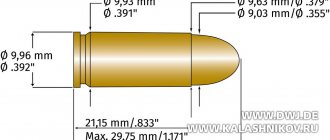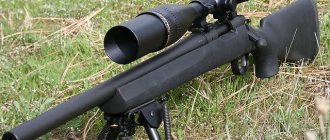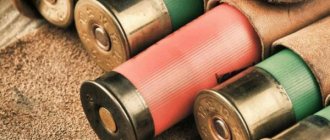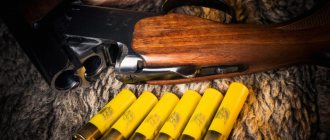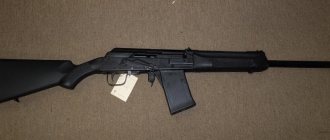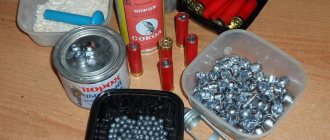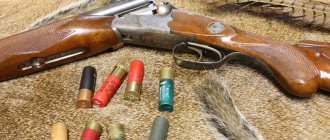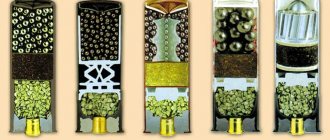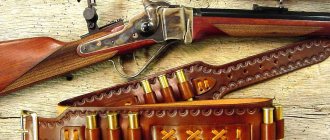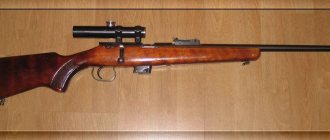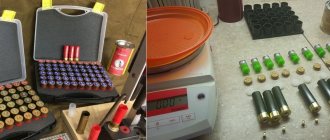- May 4, 2020
- Weapons and ammunition
- Vasilisa Odoevskaya
Every man would like to become a hunter, and at least once in his life he has dreamed of cooking game he caught with his own hands. But when hunting you will need a weapon. An important aspect of hunting is the ability to understand the caliber of a firearm; any hunter should know how the caliber of a hunting weapon is determined.
Why do you need to know the caliber of a weapon?
Knowing the caliber of a rifle or pistol will allow the hunter to choose the appropriate weapon to capture the animal. If the size of the bullet is large, then it is not worth going with it to hunt a duck or other small game, because you can make a large hole in the caught trophy, which will be of no use. And vice versa, going after a deer with a small caliber is also not wise, it will simply be ineffective.
What is a caliber?
Caliber is a word of Arabic origin, coined in Europe. They took one pound of lead and cast it into perfectly even and smooth spheres (they are bullets), the caliber depended on their quantity.
Caliber is a number that indicates the size of the barrel of a rifle or pistol and the size of the ammunition designed for various gun barrels. Caliber may also indicate the diameter of the bullet used in a firearm.
If you get 16 balls, then it is called sixteenth gauge. The smaller the diameter of the ball, the greater the number of them obtained. It turns out that the 16 gauge is smaller than the 12 gauge, and the 20 gauge is smaller than the 8 gauge, and so on.
Plastic sleeves
Plastic cartridges should provide 75 shots from 25 cartridges, and cartridges with a quality mark - 125 shots.
These cartridges do not deteriorate in a humid atmosphere and can withstand increased charges of gunpowder. But at very low temperatures (-30°C and below) they can lose elasticity. For one-time use, they are operational in a wide temperature range: from -20°C to +50°C. Main dimensions of paper sleeves (GOST 7839-68)
| Case caliber | Diameter mm | Height | Case length, mm, chamber length, mm | |||||
| d | d1 | d2 | d3 | d4 | 70 | 65 | ||
| 12 | 20.25/-0.3 | 22.45/-0.2 | 21.50/-0.2 | 20.60/-0.2 | 18.30/+0,3 | 1.50/-0.2 | 70/-1 | 65/-1 |
| 16 | 18.60/-0.3 | 20.65/-0.2 | 19.75/-0.2 | 18.90/-0.2 | 16.80/+ 0.3 | 1.25/-0.2 | 70/-1 | 65/-1 |
| 20 | 17.35/-0.3 | 19.40/-0.2 | 18.50/-0.2 | 17.70/-0.2 | 15.30/+ 0.3 | l.25/-0.2 | 70/-1 | 65/-1 |
Dimensions of brass sleeves (GOST 7921-75)
| Caliber | d | d1 | d2 | d3 | s | h | |
| 10 | 21.45/-0.3 | 21.80/-0.2 | 22,75 | 23.65/-0.2 | 0,40+0,05 | 1,50/-0,2 | |
| 12 | 20.25/-0.2 | 20.60/-0.2 | 21,50 | 22.40/-0.2 | 0,40/+0,05 | 1,50/-0,2 | |
| 16 | 18.55/-0.2 | 18.90/-0.2 | 19,75 | 20,65/-0,2 | 0,35/+0,05 | 1.25/-0.2 | |
| 20 | 17.35/-0.2 | 17.70/-0.2 | 18,50 | 19,40/-0,2 | 0,35/+0,05 | 1,25/-0,2 | |
| 28 | 15.55/-0.2 | 15.90/-0.2 | 16,50 | 17.40/-0.2 | 0,30/+0,05 | 1.25/-0.2 | |
| 32 | 13.25/-0.2 | 13.60/-0.2 | 14,50 | 15.40/-0.2 | 0,30+0,05 | 1.25/-0.2 | |
Note. The numerator is the face value; the denominator is the maximum deviation.
The easiest way to determine
How to determine caliber? It’s very simple, the fastest way is to inspect the barrel and chamber, often the cartridge size is marked there. For older firearms, the printed text may simply be unreadable. If you cannot read the caliber stamp and have no knowledge of the firearm model, you will have to go a long way by measuring the caliber yourself.
How to measure caliber
How is the caliber of a rifle determined? Two methods are usually used for this:
- The caliber of rifled weapons in Russia is measured in millimeters and is equal to the distance from the top point of the cartridge to the bottom along the diameter of the rifling. Or, in other words, the distance in the trunk from the highest point to the lowest.
- In some countries that have also adopted the metric system of measures, the caliber is measured by the cartridge, or more precisely by the diameter of the bullet, which exceeds the diameter along the rifling fields, which leads to a difference in understanding the caliber (for example, the domestic 9*18 cartridge is sometimes designated abroad as 9*218 ). Small arms calibers are divided into small - up to 6.5 mm, medium - from 6.5 to 9 mm and large - from 9 to 20.0 mm.
For other firearms, most people measure barrel length in calibers and write it in hundredths of an inch, thousands of inches, or millimeters. For example, a bullet that is 30 hundredths of an inch (.30) in diameter is a .30 caliber bullet, and traditionally there is no 0 in front of the caliber.
If you need to convert a known barrel diameter into a digital caliber value, then, given that the caliber of a smoothbore weapon is determined by a formula, you can use a simplified equation. The diameter of the weapon barrel is taken and multiplied by itself three times, then the number 76,384 is divided by the resulting number.
For example, let’s take a gun barrel diameter of 18.5 mm. To determine the caliber of a hunting weapon, we cube it and get 6331.62. Then we divide 76384 by it, and we get the value 12. It turns out that the barrel diameter of 18.5 millimeters corresponds to the twelfth gauge.
There is also a more complex calculation formula. The caliber of rifled and smooth-bore weapons is determined as follows: K * x * M = 453.6 grams (K is the caliber of the barrel, M is the mass of a round bullet with a diameter exactly the same as that of the barrel). Thanks to this formula we can determine three important aspects:
- The mass of a spherical bullet of any caliber is obtained by dividing 453.6 g by caliber.
- If you substitute the mass of the bullet, shown through the volume of the sphere and the density of lead, you can easily calculate the diameter for each type of caliber (the value will be given in millimeters). It is equal to 42.5/(cube root of caliber). The caliber can be determined if the bore diameter is known.
- The caliber will be equal to the third power of the ratio 42.5/(barrel bore diameter in mm).
In any case, it should be understood that 1 inch (1″) is equal to 25.4 mm. Here, by the way, lies the answer to the word “three-line”, that is, Mosin rifle - third-line rifle - 3 x 2.54 = 7.62 mm
32-caliber cartridges for domestic and foreign shotguns (2 photos)
Many readers are interested in 32-caliber smoothbore guns; Here are some typical questions. Why are 32-caliber smoothbore hunting weapons not produced? 32 caliber hammer? Is there a .32 caliber self-loading shotgun? I have a 32 caliber, I don’t know where to buy cartridges or cartridges for it. Refilling 32-caliber cartridges for hunting rifles. How to load a .32 caliber brass cartridge? How much gunpowder does a 32 caliber contain? Agreed shot for USSR 32 caliber?
Smooth-bore hunting weapons of 32 caliber, as interesting and valuable as they were, remain so; they are included in the production program of our factories.
However, recently it has not been in the foreground, as modern hunting conditions have led to hunters preferring guns of larger calibers. There are relatively few such weapons, and cartridges for them are not and have not been produced in our country. Nevertheless, domestic 32-caliber brass cartridges were and are still being supplied for sale, initially for the “centrifuge” capsule, and later for the “jevelo” capsule. They make it possible to supply domestic 32-caliber smooth-bore guns with cartridges of various types. On our market, 32-caliber weapons are represented mainly by single-shot ones, including those with a folding barrel produced by the Zlatoust and Izhevsk factories. There are also so-called conversion copies, that is, made from army carbines with a drilled barrel. Production is small, and hunters who are keen on small calibers are forced to be content with only these samples. However, the most attractive are the 32-caliber models with a double-barrel block, valued both as a full-fledged weapon, albeit of a small caliber, and as a weapon that allows a second shot without reloading, and as an elegant product of weapons technology. They are very rare; among the domestic ones we can only name the over-and-under “Deer” with a block of two smooth, extremely rare barrels or the even rarer Tula hammer. There is a special conversation about foreign 32-caliber smooth-bore guns. Self-loading shotguns of 32 caliber are not produced for many reasons, including a small caliber with a small shot shell, and the insignificant power of the powder charge, insufficient for reloading by inertial or gas venting methods. In our country, the lack of sleeves with paper or plastic shells also affects them. Like our other hunters, at one time I hunted with a single-shot 32-caliber single-barreled shotgun with a bolt of the S.A. Mosin system, commonly called a “frolovka.” The cartridges were loaded into domestic brass sleeves 70 mm long under a “centrifuge” primer with smokeless powder “Falcon”. Later I purchased Geco 32-caliber cartridges with a paper shell and a brass cap for a “gevelo” capsule, very convenient, but they remained unclaimed because they did not fit into the chamber. In fact, domestic and foreign 32 calibers are the same only in designation, but in fact they are different calibers, although the diameters of the barrel bores are close, since the diameters of the chambers differ significantly. As a result, cartridges and cartridges of domestic 32-caliber smooth-bore weapons turned out to be the only ones from the entire extensive generally accepted range of smooth-bore calibers that were not interchangeable with cartridges and cartridges of foreign 32-caliber. We had to somehow abandon the elegant, graceful hammer of the 32-caliber Belgian production only because our cartridges dangled in the chambers with a gap of 0.5 mm, and the mentioned German 32-caliber cartridges would only be enough for a few series of shots. Photo 1 shows how much larger foreign cartridges are than domestic ones. The history of the divergence between domestic and foreign 32 caliber is long-standing, ending at the beginning of the 20th century, during the formation of the permanent international commission CIP (PMC), which our country joined later. To distinguish these calibers, in the middle of the 20th century we designated them as follows: 32c - Soviet, 32m - international. This need was caused by the fact that a lot of foreign-made guns entered the secondary market of that time, along with the natural supply of domestic guns from Tula, Izhevsk and Zlatoust. The nominal diameter of the 32-caliber bore, determined by the classical method by the number of round bullets from one English pound of lead, is 13.36 mm. But in order to clearly separate close calibers of smooth-bore weapons from unused close ones, the CIP commission back in the second quarter of the 20th century proposed a bore diameter of 12.75 mm for the 32 caliber as a nominal bore diameter with certain limits. To be precise, this is actually a 37 caliber in terms of the number of round bullets. Domestic 32-caliber weapons have barrels with a channel of a slightly smaller diameter of 12.5 mm, which exactly corresponds to the 38-caliber in terms of the number of round bullets. But, as is customary, it is so. Let's turn to the dimensions of the barrels, the diameters of the 32-caliber channels are equal: domestic shotguns are actually 12.5 mm, foreign ones 12.7–13.2 mm. The diameters of the 32-caliber chambers are equal: for domestic shotguns at the entrance 13.60 mm, at the transition cone 13.35 mm, of course with tolerances; foreign guns at the entrance are 14.60–14.70 mm, and at the transition cone 14.30–14.40 mm. As you can see, with relatively close bore diameters, the chambers of foreign guns are wider than domestic ones. For example, on the barrel block pads of a Belgian Pieper trigger gun from the 1900s, the chamber dimensions are marked: diameter 14.6 mm and length 65 mm. To be fair, I note that the caliber on it is indicated not by the number of round bullets, but in the metric system of units of measurement. For comparison, I will give the actual dimensions of domestically produced 32-caliber brass sleeves with a length of 70 mm: the outer diameter at the welt is 13.55 mm, at the barrel 13.30 mm, at the welt 15.25 mm. A calibration ring with a width of 30 mm is recommended. Foreign-made Geco 32-caliber paper cartridges with a length of 65 mm are wider: the outer diameter at the welt is 14.40 mm, at the muzzle 14.30 mm, at the welt 16.00 mm. These are the average sizes of several sleeves, both of them, measured with an accuracy of 0.01 mm. When choosing a .32 caliber shotgun on the secondary market, the main thing is its origin: domestic or foreign. If the foreign-made barrel channels and chambers have retained the original dimensions corresponding to the stamps stamped on it, then you can only shoot international 32-caliber cartridges. But you will have to take care of the appropriate sleeves. But if the barrels of a foreign gun really correspond to the 32nd domestic caliber, then this means that before they were of some other caliber, and later drilled out, such guns are of little interest to anyone. Loading 32-caliber cartridges yourself is not difficult; felt wads are better, but wood-fiber ones are also quite acceptable, photo 2. To cut cardboard spacers into gunpowder and shot, you will need a wad grinder, sharpened so that they fit tightly in the cartridge case and bore. Domestic 32-caliber single-barreled guns are tested for strength using cartridges with a shot shell weighing 15 g and an enhanced powder charge, so this projectile mass should be considered the largest permissible. Shot cartridges of 32 caliber are equipped with a shot shell weighing 14–16 g and a charge of smokeless powder of the “falcon” type weighing 0.8–1.0 g. These are approximate parameters; during zeroing, you should select the optimal ones for your gun. For externally and internally triggered single-barreled 32-caliber guns of the IZH-ZK - IZHK and IZH-17 - IZH-18 series with a folding barrel, the Izhmekh plant recommended loading cartridges with a charge of smokeless powder weighing 0.80–0.85 g or smoky powder weighing 2.5– 3.0 g and a shell of shot weighing 15 g, weighed with an accuracy of 1 g. And for cardboard spacers for gunpowder and shot, a diameter of 12.9 mm is recommended. It is advisable to check the firing performance of a 32-caliber shotgun not only at the standard distance of 35 m, but also at a shorter distance of 20 m or 25 m, which is usual for shooting from a 32-caliber shotgun while hunting. The matched shot is selected according to the actual size of the muzzle reach; this is a typical technique for weapons of any caliber. Insert a wad into the barrel to the depth of the expected diameter of the shot and, placing shot of the same number on it tightly in one row, determine the shot of the agreed number. For the 32-caliber “frolovka”, domestic brass sleeves under the “centrifuge” primer were filled with a shot shell weighing no more than 16 g and a “falcon” charge of smokeless powder weighing no more than 1.0 grams. I hunted with it mainly for hazel grouse, and had to shoot at relatively short distances. Such cartridges gave stable results in shot firing, the power of the “centrifugal” primer was sufficient, there were no misfires or prolonged shots. Author: Evgeniy Kopeiko
Material taken: Here
Smoothbore weapons
How is the caliber of a smoothbore hunting weapon determined? Exactly the same as for a rifled one, only without taking into account the fields due to their absence. When choosing ammunition for smoothbore weapons, as with rifled barrels, it is important to take caliber into account. For a shotgun, the caliber of the projectiles is determined by the number of round spheres that can be cast from one pound of lead (just over four hundred and fifty grams). In this case, all balls must be the same in weight and diameter, which must coincide with the diameter in the middle part of the barrel.
It just so happened in history that the main role in the manufacture of weapons and ammunition for a long time was played exclusively by Great Britain. Products produced in the United Kingdom were sold all over the world and were very popular. Naturally, where English weapons and ammunition were used, it was the English measurement system that had to be used. Therefore, this payment system managed to spread throughout the world, it is still used today, and most likely will be used for a long time. Although there were attempts to change the established system of measures in history, for example, in the nineteenth, during the time of Napoleon Bonaparte, the caliber was determined by the diameter of a barrel made of 1 kilogram of lead.
The guns that have come down to us from the time of Napoleon prove the reality of such an attempt by the French leader: instead of the usual 12-gauge for a hunter, there was the number forty. You can determine the caliber only if you know the features of a rifled weapon. It turns out that this production necessity really helps those who use these weapons
The size of the groove may vary depending on the gauge value. For example, the 16 gauge has a value of 2.4 mm.
12 gauge
Among others, it is the 12-gauge cartridge that is most popular among hunters and athletes. The 12 gauge barrel length allows you to shoot a wide variety of shot sizes, as well as buckshot and slugs. This allows you to go hunting with one gun, which can be loaded with different cartridges, depending on what kind of game the hunter comes across.
IZH-54, IZH-58, IZH-43 are the most common guns that are used in different hunting conditions; the barrel length in calibers is also 12 with a barrel size of 18.5 millimeters. Moreover, different manufacturers may have different barrel diameters while maintaining the same caliber, up to 1 millimeter.
Each company has its own dimensions of tools for the production of bores of any caliber. Even in Russia, with its numerous standardizations, there are different indicators from different factories. For example, in Izhevsk they produce weapons with a diameter of 18.2 to 18.45 mm, and in Tula the channels can be 18.5-18.7 millimeters. And all these indicators correspond to 12 gauge
This happens because the channels are cylinders in the form of a truncated cone. There is a narrowing from the chamber to the muzzle. Due to this, an expansion is obtained in the main part. Each hole is made a little larger.
Although this feature is only beneficial, it allows you to increase the pressure at the end of the barrel and reduce it at the beginning, so as not to damage the wad and protect it from abrasion.
Disadvantages of 32 caliber shotguns
Unfortunately, the unpopularity of the 32 caliber is due to a fairly large list of its negative aspects. Here are just the disadvantages that are undeniable compared to 12 or 20 gauge shotguns:
32 caliber shotguns have many disadvantages.
- The projectile quickly loses its speed. The reason is a small amount of powder charge. Because of this, 32-caliber weapons are not suitable for use at long ranges, even if the bullet is used as a ballistic projectile.
- Low combat sharpness. Again, due to the relatively small mass of gunpowder and ballistic projectile (shot, buckshot, bullet), the cartridge is not suitable for hunting large animals. When shooting large game with such ammunition, the hunter runs the risk of leaving wounded animals behind.
- The accuracy of shooting depends entirely on the skills of the hunter. We are talking not only about the ability to quickly aim at a moving target, but also to correctly calculate the distance to the target, otherwise the spread of the shot will be too large.
- A spherical bullet has a flat trajectory. That is, to shoot from a distance of even 100 meters, you have to raise the front sight and shoot above the target. This causes some inconvenience, especially when using standard sights.
- Powder consumption is almost the same as that of large-caliber cartridges. 12 or 16 gauges use magnum powder, which has a slow burning rate. 32-caliber ammunition uses fast-burning gunpowder in almost the same weight.
- Shot and buckshot deform the walls of the barrel channel. The reason for this is simple - the column of the ballistic projectile in the cartridge is too high (due to the narrow cartridge case). So it turns out that the service life of a 32 caliber gun is noticeably shorter.
- Difficulty in purchasing ammunition. Remember the last time you saw a wide range of 32 caliber cartridges in a gun store? Usually they are not even put on display, but lie somewhere on the side, waiting for the buyer.
- Difficulty in loading cartridges yourself. Basically it lies in the fact that wad containers cannot be used in 32 caliber cartridges. In addition, most guns are designed to fire brass shells, which are very difficult to roll.
Sixteen gauge
Easier to handle - 16 gauge. This type of ammunition became most widespread in Soviet times due to the mass production of Tula arms factories. Now Russian manufacturers practically do not produce guns of this caliber. Hunting rifles are made in Italy and France. The weapon is lighter than the twelfth, but more powerful and cheaper than the twentieth. Very often, weapon models of this caliber have a pump-action design without a stock. 1st gauge is popular among security personnel, although some hunters call it “dying.”
Caliber .308
Caliber .308 is an analogue of the Soviet cartridge 7.62x51. There is a legend that the .308 caliber first appeared in Russia thanks to the President of the United States, when he gave a Winchester carbine to Leonid Brezhnev, who was very fond of hunting and immediately went to it. There, Leonid Ilyich liked the gun so much that he ordered the production of this cartridge, as well as weapons for it.
Of the advantages of the .308 Win cartridge. Most hunters note that this ammunition of foreign origin is very versatile. The bullet hits both small-sized game (squirrel, fox and others) and larger ones (deer and wild boar). This cartridge is not suitable for large animals, because the animal does not die instantly, and severe wounding will only make it angry. It is likely that the game may simply attack.
Subsequently, after several years of practical comparisons of manufactured weapons, the Soviet Union released the Los-7 rifle, which had a .308 caliber barrel length of 625 millimeters. This weapon fully satisfied the needs of both domestic and foreign hunters.
Caliber selection
First of all, the caliber determines the purpose of the rifled barrel. Unlike smooth-bore weapons, where guns from 10 to 16, and partly 20 calibers solve the same or similar problems, I must say, with different effectiveness, rifled calibers have a narrower specialization. It is the caliber that determines the difference between rifled weapons intended for shooting gophers and weapons intended for hunting elephants.
The basic rule that allows one to roughly determine the suitability of ammunition of a particular caliber for shooting a specific type of game fauna is the energy of the bullet at the impact distance, equal to or greater than the animal’s body weight (with an energy value expressed in kgf.m.), or 10 times greater than the body weight (with energy value expressed in J). Body weight in both cases in kg. If you fulfill this condition of matching the energy to the body weight of the animal, you will protect yourself from unnecessary wounded animals, of course, provided that they end up in the slaughter area. But the killing area also has larger dimensions, the higher the energy of the bullet, that is, cartridges with more energy allow less accurate shooting.
It is also necessary to remember that the bullet will only give up its energy to the animal’s body when it remains in it after being hit, and does not pierce right through the carcass. Thus, soft, relatively quickly deforming bullets with a flat (blunt) nose are preferred.
For example, a Silvertip bullet of .308Win caliber weighing 9.7g from a Winchester cartridge will certainly be sufficient to shoot a red deer weighing 200kg at a distance of up to 200-220m, since its energy at these distances will be at least 2000J.
However, we must not forget that in addition to lethality, an important and sometimes decisive factor in hunting is not energy, but the stopping power of ammunition. What good is it if you kill a bear with a 7x64 caliber bullet that hits the lungs? He will die 5, or even 25 kilometers from the point where the bullet hit. If you don't find it, the precious trophy will be wasted.
The stopping effect of a bullet is proportional to its cross-sectional area (that is, the square of its radius), so a .375H&H caliber bullet with a diameter of 9.53mm will stop an animal 1.34 times better than a bullet of the same design with an 8x57JS caliber with a diameter of 8.22mm, assuming the same mass , speed and uniformity of design.
And due to the fact that the stopping power of bullets is also proportional to their mass, large-caliber bullets stop better in this regard as well. So the lightest bullet of .375H&H caliber has a mass of 17.5g, and the heaviest 8x57JS 13.0g (from factory cartridges), therefore, while maintaining the ratio of calibers mentioned above, the difference in mass will add another difference in stopping power, and these the calibers will actually differ by no less than 1.34x(17.5:13.0)=1.8 times! Taking a regular 19.5g bullet for the .375H&H, we get the ratio of the relative stopping effects of these calibers to be 1.34x(19.5:13.0) = 2 times! It immediately becomes clear which calibers are preferable when shooting large animals.
Moreover, large calibers allow for guaranteed shooting of an animal when it hits not only places with high lethality (brain and spinal cord, heart, etc.), but also when shooting at muscle tissue bordering these organs and the lungs, which is certainly expands the possibilities of using weapons. Especially when used on animals that are in motion, which makes accurate aiming difficult.
The stopping effect of a bullet conflicts with the range of the ammunition, since, other things being equal (weight and initial speed), bullets with a good stopping effect, that is, flat-nose ones, have worse performance in terms of speed drop along the trajectory than pointed-nose bullets for long-range shooting . The 15.55g blunt-nosed .444 Marlin bullet with a muzzle velocity of 716 m/s has a muzzle energy of 3993 J and brilliant stopping power.
A .30-06 caliber bullet weighing 9.7g with an initial speed of 906 m/s has an energy of 3981 J, that is, almost the same. However, its stopping power, due to its smaller mass and diameter, is almost three times less than that of the .444, and without even taking into account the effect of the flat head of the bullet. But at a distance of 100 m, the energy of the same ammunition is already correlated as 2266 J to 3070 J, and the ratio is in favor of the .30 caliber. Therefore, in any case, when choosing a caliber, you need to think about how much you are willing to sacrifice the stopping effect of a bullet to the detriment of range and vice versa.
It is important to understand that there is a concept of direct shot distance (DSD). This is the value that determines at what distance, without changing the sight settings, you can hit the target’s killer spot. The question is what is the diameter of this slaughter place. In Europe, when determining the DPV, which they designate as GEE, the diameter of the slaughter zone is taken to be 80 mm, which from their point of view is equal to the diameter of the roe deer’s heart (although what does the roe deer have to do with it if we consider GEE for .375H&H?). Thus, when determining the DPV, the bullet on the trajectory should not rise by more than 40 mm and fall by the same amount. Pay attention to any ballistic table, move the trajectory of the ballistic calculator and think about how the bullets fly along the trajectory and how much this corresponds to your ideas about the process.
By the way, it is necessary to remember that as the distance increases, the actual size of the killing zone decreases, due to the fact that the energy of the bullet decreases. For example, when shooting at a moose, at a distance of 100m with a 9.3x62 caliber bullet it is enough to hit the lungs, that is, approximately in the 60x40cm zone. Plus the heart, brain and spinal cord, liver. At 400m, to stop the beast, you only need to hit the heart and brain, that is, the actual size of the killing zone is reduced several times. Well, in the case when the size of the lethal zone is so small, to confidently defeat it you need a rangefinder and an optical sight with high magnification (read large and heavy).
The same goes for the common question about shooting animals with small calibers. The less energy the bullet has at the moment of impact, the more accurately you must shoot. Vividly imagine yourself on a driven hunt, on the edge of a snow-covered field, with the need to hit not even the head, but the brain of a running elk 200 meters away from a Bars-4 in 5.6x39 caliber. Have you imagined what is needed for this? But from the same 9x53R, reviled by everyone, it’s enough to hit the lungs, and the moose is yours!
This is how the legends about how “one friend shoots moose exclusively from the Bars!” are debunked.
All other things being equal (the cost of cartridges and weapons, its weight and availability, etc.) for hunting the same animal, a larger caliber is undoubtedly preferable to a small one in terms of harvestability. In Sweden, many hunters historically use weapons chambered for 6.5×55 Swiss, which has an energy of about 2500-2700 J at 100m, to shoot elk. However, they hunt there mainly from the approach, having the opportunity to carefully aim at the slaughter area. In Russia, with its traditionally driven hunts, the minimum caliber for elk is .308 Win, preferably 7.62x54R, and even better 8 mm or more. The author prefers 9.3 mm and is not the original. Calibers .338 Win Mag; 9.3×62; 9.3x74R, not to mention .375 H&H, even allows hard bullets to be fired at large elk at distances of up to 100-150m, piercing the carcass from the anus to the lungs. Having medium (.30 or 8mm) caliber weapons, it is not at all recommended to shoot in such conditions.
The main conclusion: it is much better if the caliber you choose is excessive in energy for shooting a particular type of game than insufficient.
Just please, do not take what I wrote above as a call to use .375H&H on a roe deer, which will die from being hit in the rear thigh by a bullet from this cartridge. Remember that any excess is inappropriate; in the example shown, the roe deer will only have a hematoma and horns with hooves.
Let's briefly look at the principles of caliber distribution among hunting objects.
Calibers for small game hunting
The most suitable for hunting large birds (grouse, wood grouse, sometimes goose) and small animals (fox) is a rifled weapon of .22 Hornet caliber; .222Rem; .22-250; .223Rem; 5.6x50Rmag; 5.6x39; 5.6x52R; 5.6×57; 5.6x57R and .243Win. Undoubtedly, they have different energies and indicators of bullet flatness on the trajectory, but, as a rule, they allow one to hunt the mentioned species quite successfully, without causing much damage to the carcasses or skin of the game.
.22Horn is used at shooting distances up to 150m, 5.6x57 and 243 up to 300m, the rest up to 200-250m. It should be remembered that light .22-caliber bullets are subject to significant wind drift along their trajectory. For example, a bullet from a Norma cartridge in caliber .222Rem weighing 3.24 g in an average wind of 5 m/s blowing at an angle of 90 degrees to the trajectory will deviate at a distance of 250 m by 44 cm, which will lead to a guaranteed miss when shooting at a fox looking not only straight ahead at the shooter, but also standing sideways.
Moreover, the wind is often not constant in vector and strength, and therefore cannot be taken into account accurately. Heavier bullets are blown away by the wind much less, so a .308 caliber bullet weighing 9.7g will be blown away by half as much in the example shown.
However, it should be remembered that in many regions hunting birds with rifled weapons is prohibited.
Calibers for hunting medium-weight animals
Medium game usually means animals weighing up to 100-150 kg, such as wolves, roe deer, small and medium wild boar, sika deer, small elk, etc. However, it is clear that the approach to shooting a European roe deer weighing 30 kg and a moose calf weighing 150 kg should be different.
It would probably be correct to divide medium-sized animals into two groups:
First group: animals weighing up to 60-80 kg.
These are European and Siberian roe deer, saiga, wolf, etc.
A good choice would be: 223Rem; 5.6x50R; 5.6×57; 5.6x57R with heavy expansion bullets weighing 4-5 grams at distances up to 200m. Any options for .243Win and other 6.5mm caliber cartridges (6.5x55; x57, etc.) are good at all reasonable shooting distances. Jacketed bullets of 7mm (7x57; x57R; .270Win; 7x64; 7x65R) and .30-caliber cartridges are suitable (7.62x39 is very good at distances up to 200m, .308Win; .30-06 and 7.62x54R), also at any distance that allows you to make a confident shot in place.
Second group: animals weighing 100-150 kg.
These are small spotted deer, mountain sheep, reindeer, small and medium-sized wild boar, small elk, etc. Here we can talk about the use of 6.5 mm calibers only at distances up to 150, in extreme cases up to 200 m, and even then with the heaviest expansive bullets. 7mm calibers with hollow-point bullets are preferred. The .30 calibers listed above are also good, in versions with hollow-point bullets. You can confidently shoot 8mm ammo (8x57, 8x64 and 8x68), with hollow point bullets only being extremely powerful in the latter two calibers.
Calibers for hunting big game.
By large game for the territory of Russia we usually mean animals with a body weight of 150-200 kg or more. These are large deer (elk, deer, wapiti), wild boars and bears. Moreover, the last two types of game are extremely resistant to wounds.
The minimum suitable for hunting these animals seems to be .30-caliber weapons (however, in no case are 7.62x39, but .308Win; 7.62x54R; .300WinMag; .30-06) with the heaviest expansive bullets possible in them and at distances up to 200m. Much more suitable would be 8mm ammunition, also with hollow-point bullets. But the best performance in the case under consideration is provided by cartridges of calibers .338WinMag; .35Wheelen (up to 200m); 9.3x74R; 9.3×62 and 9.3×64, as well as .375H&H Mag, allowing you to confidently not only hit the game, but in most cases quickly enough to stop it at the point of impact of the bullet or not far from it.
Briefly about domestic cartridges.
In general, in recent years, the range of cartridges for rifled weapons produced by Russian enterprises has expanded significantly and, what is especially pleasant, their quality has improved. Cartridges began to be produced that had not only bimmetal, but also tombak bullet casings, which did not wear out the rifling as much. Analogues of foreign cartridges have appeared. However, we cannot say that problems with the stability of ammunition quality have been resolved.
Currently, Russia produces cartridges for rifled long-barreled weapons in .223Rem caliber; 5.6×39; 7.62×39; .308Win(7.62×51); 7.62x54R; .30-06(7.62x63); 9x53(54R), by the way, is a very good cartridge for solving assigned tasks at distances up to 150m, in most cases the limit when shooting in the forest, and recently appeared in the 9.3x64 production program. Of all the above, the greatest surprise is 9.3x64; why it was necessary to launch production of a caliber that has virtually no prospects in foreign markets is not entirely clear. An analogue with one type of bullet is produced only by RWS, and the weapon is mass-produced by two manufacturers. From my point of view, it would be much more justified to organize the release of .375H&H, or several lower energy 9.3x62 or .338Win Mag.
To conclude this brief discussion of calibers, it is necessary to mention shooting at mountain game, and accordingly note a separate group of cartridges for this. Animals living in the mountains rarely have a large mass, and here the flatness of ammunition, which is required when shooting in the mountains, comes to the fore. Primarily mountain calibers are .243Win for chamois, for larger mountain sheep and goats it is 7mmRemMag; .300WinMag; .30R Blaser and 8x68S. Bullets of cartridges of these calibers are capable of hitting any mountain dweller at all possible shooting distances, thanks to their exceptional flatness.
I would like to warn the reader against one common misconception, that is, from the desire to select the caliber of rifled weapons according to the criterion for the production of ammunition by domestic manufacturers. The point is the following: firstly, none of the Russian factories yet produces cartridges equal to leading Western manufacturers. Maybe only TPZ in individual batches of .223Rem, produced under the Wolf brand, approaches the worst, such as cheap Winchester. Secondly, as usual, they shoot from rifled weapons much less than from smooth-bore weapons; the cost savings will not be as great as one might expect. Thirdly, the price of domestic cartridges is very close to foreign models (for example, the Barnaul .30-06 costs almost the same as S&B), with generally worse quality and a smaller assortment of bullets.
Well, in conclusion, we must not forget that all domestic rifled barrels are chrome-plated, but foreign ones are not. Chrome coating prevents rapid wear of the barrel rifling when firing domestic ammunition with bullets that have a bimetallic jacket and, often, steel cores. The non-chromed barrel of a foreign-made carbine may “end” faster. On the other hand, in the absence of chromium, accuracy is usually better, but its presence reduces shooting accuracy.
In order to reduce the volume of the opus, I will limit myself to considering weapons for calibers intended for the most part for hunting medium and large game.
How is gauge referred to in the metric measurement system?
Metric measurement is the most common option used around the world. And yet it is completely different from the inch measuring system. Let's take for example a 9mm pistol that has a barrel or barrel diameter of 9mm. There is no longer a decimal point and you don't use the word "caliber".
Therefore, instead of saying “9 mm caliber,” it would be correct to say that it is a “9 mm pistol.” However, some gun enthusiasts use the word "caliber" to refer to the bore diameter, regardless of the measurement system.
For example, some gun owners like to ask about the caliber of a friend's pistol: "What caliber pistol are you using?" Even if a person has metric caliber information but uses the word caliber, gun owners will know that he is referring to the overall diameter of the barrel when answering.
Calibers of rifled weapons
The caliber of a rifled weapon is much simpler to calculate than the caliber of a smoothbore weapon: this is the diameter of the bore, measured along the fields. Despite the wide selection of calibers, there are several that are widely used among shooters.
One of the most popular calibers is .308 Win, produced not only by NATO countries, but also by domestic enterprises. Even though the cartridge case of this caliber is smaller, the muzzle velocity of the bullet is slightly higher, which improves ballistic characteristics. This is perhaps the most common sniper and machine gun caliber used by NATO countries, and therefore there are a great many companies producing this ammunition in excellent quality. The Russian analogue of this ammunition is 7.62/54R, a common and fairly cheap caliber with high power.
The next most popular caliber is the .300 Win Mag, which is already quite an expensive ammunition, which is also available in rifles and carbines of the same level. This caliber provides an initial bullet speed of up to 1000 m/s, allows you to confidently shoot at a distance of 600 meters, and its power is enough to hunt game weighing up to 350 kg. It is important to consider that this caliber requires careful storage and care. The higher the distance and the more powerful the caliber, the higher the initial speed of the bullet, the correspondingly longer the barrel, in which the bullet accelerates and has more energy when exiting the barrel. Any error in the bore can lead to very large errors, for example, to separation when firing. This is why it is so important to properly care for your equipment.
Another popular caliber is .22 LR; this is the smallest caliber of rifled weapons, used both for initial shooting training (due to minimal recoil when fired) and for hunting small fur-bearing animals. The .22 WMR caliber is similar to it, differing only in greater power and used to kill not only fur-bearing animals, but also game birds, since the destruction distance increases.
The .223 Rem caliber from a well-known armory is also widely used among shooters, as it has great power and penetrating ability, and is excellent for hunting not only any bird, but also medium game, for example, a wolf or a roe deer. Next up is the .243 Win, developed and renowned for its low recoil and high accuracy, as well as its ability to shoot out to 700 meters (by comparison, the .223 Rem has a maximum range of 500 meters when used in a bolt action carbine). .
30-06 Sprg is considered one of the most powerful calibers and is actively used in the USA. In fact, this caliber is the progenitor of all 300 calibers and is excellent for both sport shooting and hunting large game, for example, bear. However, this caliber can also be used for hunting smaller targets. The 30-06 Sprg has a capacious powder chamber and excellent stability of flight characteristics, which allows hunters to use almost any bullet.
What are cartridges?
A cartridge is a single unit of ammunition consisting of a case, primer and propellant charge with or without one or more projectiles (called blank cartridges). You can often hear in the lexicon the use of the term “bullet” to mean a cartridge, which is erroneous, because a bullet is just a charge that flies out of the barrel.
The cartridge designation usually includes a numerical name that indicates the approximate diameter of the bullet and usually includes the name of the manufacturer.
Caseless cartridge
What a caseless cartridge is is clear from its name. But what advantages does it have over the standard one, what is it needed for, and is there such ammunition?
The term “caseless cartridge” should not necessarily be taken to mean that the cartridge does not have a case as such. The goal is to ensure that nothing remains after the shot. That is, cartridges with combustible cartridges also belong to this type.
This is exactly what the very first ammunition was like - they were rolled out of paper, which burned completely at the moment of the shot. Such cartridges were used in revolvers, but their appearance on sale was explained only by the fact that they were inexpensive and easy to manufacture. They did not have any advantages or advantages.
Features of domestic and imported cartridges
If you decide to get a 32-caliber shotgun, you should know that domestic and imported cartridges have some differences. The main one, of course, is the size of the cartridges - in Russian cartridges the maximum ammunition diameter is 12.5 millimeters, while American and European cartridges range in size from 12.7 to 13.3 millimeters.
So it turns out that when buying a domestic shotgun “Olen”, a single-barreled IZH-17 or IZH-18, or some kind of shotgun based on the “Mosinka”, it is extremely important to select domestic ammunition for it, otherwise problems may arise during shooting. At the same time, buying Russian ammunition for an American or Belgian gun is not the best idea, since the cartridge case will simply dangle in the chamber.
